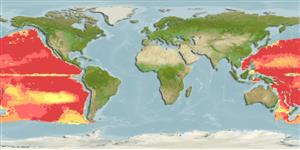Actinoptérygiens (poissons à nageoires rayonnées) >
Stephanoberyciformes (Pricklefishes, bigscales and gibberfishes) >
Melamphaidae (Bigscale fishes or ridgeheads)
Etymology: Poromitra: Greek, poros = porous + Greek, mitra = stripe, belt (Ref. 45335).
Environnement / Climat / Gamme
Écologie
; marin bathypélagique; profondeur 700 - 900 m (Ref. 559). Tropical, preferred ?
Distribution
Pays | Zones FAO | Écosystèmes | Occurrences | Point map | Introductions | Faunafri
Pacific Ocean: from the Philippines to the Hwaiian Islands.
Taille / Poids / Âge
Maturity: Lm ? range ? - ? cm
Max length : 11.4 cm SL mâle / non sexé; (Ref. 83717)
Description synthétique
Morphologie | Morphométrie
Épines dorsales (Total): 3; Rayons mous dorsaux (Total): 11; Épines anales 1; Rayons mous anaux: 8; Vertèbres: 25 - 26. This species is distinguished by the following: spinulated (without gap) posterior and lower edges of praeoperculum; insertion of ventral fins in front of the vertical of posterior eye edge; soft rays in dorsal 11 and in anal fin 8; rakers at the first gill arch 29-33; vertebrae 25-26; pyloric caeca 9-11 (Ref. 83717).
Collected with non-closing fishing gear that precise depths of its occurrence is undetermined. Depths of catches are 200-0 minimum and 5300-0 maximum (Ref. 83717).
Life cycle and mating behavior
Maturité | Reproduction | Frai | Œufs | Fécondité | Larves
Kotlyar, A.N., 2008. Revision of the genus Poromitra (Melamphaidae): Part 1. Species of group P. crassiceps. J. Ichthyol. 48(7):479-492. (Ref. 83717)
Statut dans la liste rouge de l'IUCN (Ref. 115185)
CITES (Ref. 94142)
Not Evaluated
Menace pour l'homme
Harmless
Utilisations par l'homme
Plus d'informations
PaysZones FAOÉcosystèmesOccurrencesIntroductionsStocksÉcologieRégime alimentaireÉléments du régime alimentaireConsommation alimentaireRation
Noms communsSynonymesMétabolismePrédateursÉcotoxicologieReproductionMaturitéFraiFéconditéŒufsDéveloppement de l'œuf
Taille/ÂgeCroissanceLongueur-poidsLongueur-longueurFréquences de longueursMorphométrieMorphologieLarvesDynamique des populations larvairesRecrutementAbondance
RéférencesAquacultureProfil d'aquacultureSouchesGénétiqueFréquences alléliquesHéritabilitéPathologiesTraitementMass conversion
CollaborateursImagesStamps, CoinsSonsCiguateraVitesseType de nageSurface branchialeOtolithesCerveauxVision
Outils
Articles particuliers
Télécharger en XML
Sources Internet
